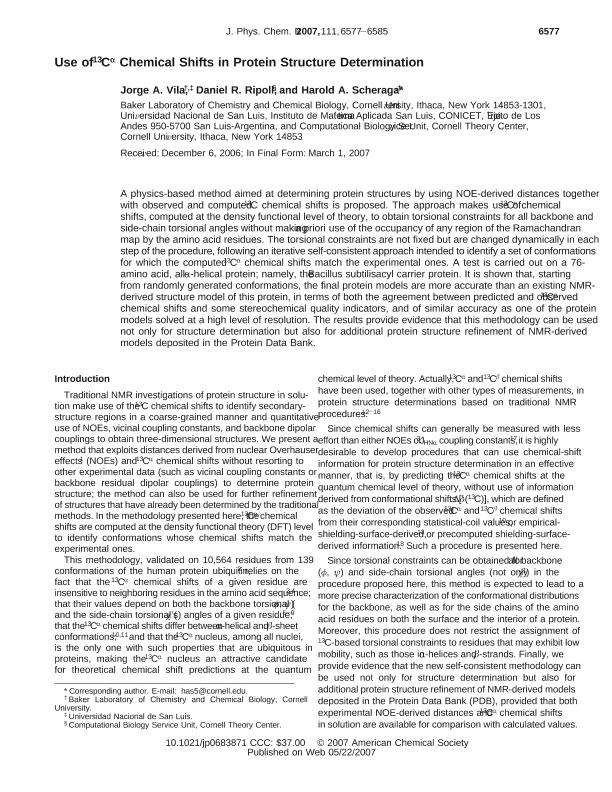Mostrar el registro sencillo del ítem
dc.contributor.author
Vila, Jorge Alberto

dc.contributor.author
Ripoll, Daniel R.
dc.contributor.author
Scheraga, Harold A.

dc.date.available
2021-06-29T18:07:11Z
dc.date.issued
2007-05
dc.identifier.citation
Vila, Jorge Alberto; Ripoll, Daniel R.; Scheraga, Harold A.; Use of 13Ca chemical-shifts in protein structure determination; American Chemical Society; Journal of Physical Chemistry B; 111; 23; 5-2007; 6577-6585
dc.identifier.issn
1520-6106
dc.identifier.uri
http://hdl.handle.net/11336/135117
dc.description.abstract
A physics-based method aimed at determining protein structures by using NOE-derived distances together with observed and computed 13C chemical shifts is proposed. The approach makes use of 13Cα chemical shifts, computed at the density functional level of theory, to obtain torsional constraints for all backbone and side-chain torsional angles without making a priori use of the occupancy of any region of the Ramachandran map by the amino acid residues. The torsional constraints are not fixed but are changed dynamically in each step of the procedure, following an iterative self-consistent approach intended to identify a set of conformations for which the computed 13Cα chemical shifts match the experimental ones. A test is carried out on a 76-amino acid, all-α-helical protein; namely, the Bacillus subtilis acyl carrier protein. It is shown that, starting from randomly generated conformations, the final protein models are more accurate than an existing NMR-derived structure model of this protein, in terms of both the agreement between predicted and observed 13Cα chemical shifts and some stereochemical quality indicators, and of similar accuracy as one of the protein models solved at a high level of resolution. The results provide evidence that this methodology can be used not only for structure determination but also for additional protein structure refinement of NMR-derived models deposited in the Protein Data Bank.
dc.format
application/pdf
dc.language.iso
eng
dc.publisher
American Chemical Society

dc.rights
info:eu-repo/semantics/openAccess
dc.rights.uri
https://creativecommons.org/licenses/by-nc-sa/2.5/ar/
dc.subject
PEPTIDES AND PROTEINS
dc.subject
MONOMERS
dc.subject
PROTEIN STRUCTURE
dc.subject
CHEMICAL STRUCTURE
dc.subject
CONFORMATION
dc.subject.classification
Física Atómica, Molecular y Química

dc.subject.classification
Ciencias Físicas

dc.subject.classification
CIENCIAS NATURALES Y EXACTAS

dc.title
Use of 13Ca chemical-shifts in protein structure determination
dc.type
info:eu-repo/semantics/article
dc.type
info:ar-repo/semantics/artículo
dc.type
info:eu-repo/semantics/publishedVersion
dc.date.updated
2020-09-24T14:26:49Z
dc.journal.volume
111
dc.journal.number
23
dc.journal.pagination
6577-6585
dc.journal.pais
Estados Unidos

dc.description.fil
Fil: Vila, Jorge Alberto. Consejo Nacional de Investigaciones Científicas y Técnicas. Centro Científico Tecnológico Conicet - San Luis. Instituto de Matemática Aplicada de San Luis "Prof. Ezio Marchi". Universidad Nacional de San Luis. Facultad de Ciencias Físico, Matemáticas y Naturales. Instituto de Matemática Aplicada de San Luis "Prof. Ezio Marchi"; Argentina. Cornell University; Estados Unidos
dc.description.fil
Fil: Ripoll, Daniel R.. Cornell Theory Center; Estados Unidos
dc.description.fil
Fil: Scheraga, Harold A.. Cornell University; Estados Unidos
dc.journal.title
Journal of Physical Chemistry B

dc.relation.alternativeid
info:eu-repo/semantics/altIdentifier/doi/https://doi.org/10.1021/jp0683871
dc.relation.alternativeid
info:eu-repo/semantics/altIdentifier/url/https://pubs.acs.org/doi/10.1021/jp0683871
Archivos asociados
